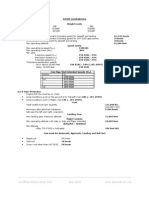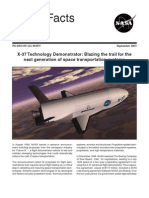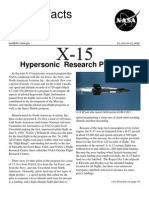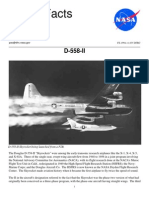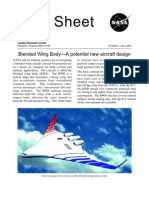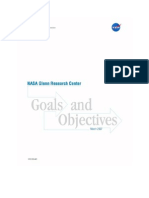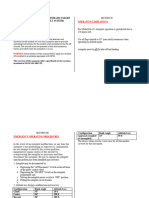NASA 171791main FS-090-DFRC
NASA 171791main FS-090-DFRC
Uploaded by
NASAdocumentsCopyright:
Available Formats
NASA 171791main FS-090-DFRC
NASA 171791main FS-090-DFRC
Uploaded by
NASAdocumentsCopyright
Available Formats
Share this document
Did you find this document useful?
Is this content inappropriate?
Copyright:
Available Formats
NASA 171791main FS-090-DFRC
NASA 171791main FS-090-DFRC
Uploaded by
NASAdocumentsCopyright:
Available Formats
X-48B Blended Wing-Body
Boeing Phantom Works has partnered percent better fuel economy than
with NASA and the Air Force Re- traditional aircraft due to its unique
search Laboratory to study the struc- shape, a combination flying wing
tural, aerodynamic and operational merged with a triangular body.
advantages of the Blended Wing
Body concept, a cross between a The Blended Wing Body research
conventional plane and a flying wing team successfully completed 250
design. The Air Force has designated hours of wind tunnel tests on X-48B
the prototype the X-48B based on its Ship No. 1 at the historic full-scale
interest in the design’s potential as a wind tunnel at NASA’s Langley
multi-role, long-range, high-capacity Research Center in Hampton, Va.,
military transport aircraft. In May 2006. NASA’s Dryden Flight
Research Center at Edwards Air
The program’s goal is to learn more Force Base, Calif., is hosting the X-
about the low-speed flight-control 48B flight test activities and provid-
characteristics of the concept when ing in-depth flight research expertise
applied to large transport or cargo air- garnered from years of operating a
craft. Engineers are also intrigued by variety of cutting-edge unmanned
the design’s potential to get up to 30 air vehicles.
X-48B at Dryden Flight Research Center on Rogers Dry Lake ED06-0201-1
Following completion of installation of test The two X-48B Blended Wing Body tech-
instrumentation, the second X-48B Blended nology demonstration aircraft were built by
Wing-Body technology demonstrator began Cranfield Aerospace in the United Kingdom to
ground checkout at NASA Dryden in late Boeing’s specifications. The subscale pro-
2006, with five test flights in early 2007. Flight totypes have a wingspan of 20.4 feet, with
testing at NASA Dryden was to focus on the prominent vertical fins and rudders at the
low-speed, low-altitude flight characteris- wingtips and elevons along the trailing edges
tics of the blended wing-body configuration, of the wings. Three small model aircraft turbo-
including engine-out control, stall character- jet engines, providing a maximum combined
istics and handling qualities. The short flight thrust of about 160 lbs, power the 523-lb.
test program was designed to demonstrate gross weight aircraft. The X-48B has an esti-
that the novel design can be flown as safely mated top airspeed of 118 knots (138 mph), a
as current transports having a traditional fu- maximum altitude of about 10,000 feet and a
selage, wings and tail configuration. The 8.5 flight duration of about 40 minutes.
percent scale, remotely piloted X-48B is dy-
namically scaled to fly much like the full-size Read more on the X-48B at: (http://www.boeing.
aircraft would fly. com/news/releases/2006/q4/061027b_nr.html)
X-48B in full-scale wind tunnel at NASA’s Langley Research Center ED06-0070-1
National Aeronautics and Space Administration
Dryden Flight Research Center
P,O. Box 273
Edwards, CA 93523-0273
Voice 661-276-3449 FAX 661-276-3566
pao@dfrc.nasa.gov
NASA Facts
FS-2006-11-090-DFRC
You might also like
- Falcon - 2000 - PTM - V2r2 - MCD Description Des Systemes PDFDocument387 pagesFalcon - 2000 - PTM - V2r2 - MCD Description Des Systemes PDFRodrigo Alvarenga100% (2)
- Peregrine AML STC KT74Document184 pagesPeregrine AML STC KT74AeromechanixNo ratings yet
- Airbus LeafletDocument32 pagesAirbus LeafletReggie Joshua100% (1)
- Sounding RocketDocument16 pagesSounding RocketFrancesca LazzarottiNo ratings yet
- A 330 OralDocument22 pagesA 330 OralMoataz Mohammad Naguib70% (10)
- Aircraft Design 2018 SmallerDocument707 pagesAircraft Design 2018 SmallerEdward Ramos100% (3)
- Pilot JungmeisterDocument8 pagesPilot JungmeisterEstevam Gomes de AzevedoNo ratings yet
- Catalog of Standard Upgrades AH-Nov2015 PDFDocument244 pagesCatalog of Standard Upgrades AH-Nov2015 PDFWorawat Wong100% (1)
- Boeing 747 400 ChecklistDocument2 pagesBoeing 747 400 Checklistgittscibd100% (6)
- (All Aircraft Models) Mk-Xxii Egpws 060-4314-250 Installation ManualDocument324 pages(All Aircraft Models) Mk-Xxii Egpws 060-4314-250 Installation ManualPaulo Bernardo100% (1)
- x48b DimensionsDocument2 pagesx48b Dimensionsdudeanonymous2000No ratings yet
- NASA 174286main X37-HistoricalDocument2 pagesNASA 174286main X37-HistoricalNASAdocumentsNo ratings yet
- Balls Eight: History of the Boeing Nb-52b Stratofortress MothershipFrom EverandBalls Eight: History of the Boeing Nb-52b Stratofortress MothershipNo ratings yet
- NASA: 71296main 03-067Document2 pagesNASA: 71296main 03-067NASAdocumentsNo ratings yet
- NASA Facts F-15B Research Testbed 2001Document3 pagesNASA Facts F-15B Research Testbed 2001Bob AndrepontNo ratings yet
- NASA Facts B-52B Launch AircraftDocument3 pagesNASA Facts B-52B Launch AircraftBob Andrepont100% (1)
- Backgrounder: X-37B Orbital Test VehicleDocument3 pagesBackgrounder: X-37B Orbital Test VehiclejuniormirandaNo ratings yet
- NASA Facts B-52B Launch AircraftDocument4 pagesNASA Facts B-52B Launch AircraftBob AndrepontNo ratings yet
- NASA Facts The Blended-Wing-BodyDocument4 pagesNASA Facts The Blended-Wing-BodyBob AndrepontNo ratings yet
- NASA 120309main FS-055-DFRCDocument3 pagesNASA 120309main FS-055-DFRCNASAdocumentsNo ratings yet
- NASA Facts X-36 Tailless Fighter Agility Research Aircraft 2002Document2 pagesNASA Facts X-36 Tailless Fighter Agility Research Aircraft 2002Bob AndrepontNo ratings yet
- NASA: 142891main X43A 2006Document4 pagesNASA: 142891main X43A 2006NASAdocumentsNo ratings yet
- X-48B Flight-Test Progress Overview: NASA Dryden Flight Research Center, Edwards, CA 93523 andDocument17 pagesX-48B Flight-Test Progress Overview: NASA Dryden Flight Research Center, Edwards, CA 93523 andAmin AnjomNo ratings yet
- NASA Facts X-15 Hyper Sonic Research ProgramDocument6 pagesNASA Facts X-15 Hyper Sonic Research ProgramBob AndrepontNo ratings yet
- NASA Facts HiMAT Highly Maneuverable Aircraft Technology 1998Document3 pagesNASA Facts HiMAT Highly Maneuverable Aircraft Technology 1998Bob AndrepontNo ratings yet
- NASA Facts Altair Predator B 2001Document3 pagesNASA Facts Altair Predator B 2001Bob AndrepontNo ratings yet
- NASA: 71352main 04-034Document2 pagesNASA: 71352main 04-034NASAdocumentsNo ratings yet
- NASA Facts X-37 Demonstrator To Test Future Launch Technologies in Orbit and Reentry Environments 2001Document2 pagesNASA Facts X-37 Demonstrator To Test Future Launch Technologies in Orbit and Reentry Environments 2001Bob AndrepontNo ratings yet
- NASA 100427main X37-FactsDocument2 pagesNASA 100427main X37-FactsNASAdocumentsNo ratings yet
- NASA 120395main FS-010-DFRCDocument2 pagesNASA 120395main FS-010-DFRCNASAdocumentsNo ratings yet
- NASA Facts NASA Hyper-X Program Demonstrates Scramjet Technologies 2002Document4 pagesNASA Facts NASA Hyper-X Program Demonstrates Scramjet Technologies 2002Bob AndrepontNo ratings yet
- Scramjet-Separation NASADocument12 pagesScramjet-Separation NASASREENATH S.SNo ratings yet
- NASA Facts F-15 B Aerodynamic Flight FacilityDocument3 pagesNASA Facts F-15 B Aerodynamic Flight FacilityBob AndrepontNo ratings yet
- QuietingtheBoom Pres 082223redDocument31 pagesQuietingtheBoom Pres 082223redMartin PospisilNo ratings yet
- NASA Facts HL-10 Lifting Body 1995Document3 pagesNASA Facts HL-10 Lifting Body 1995Bob AndrepontNo ratings yet
- High Altitude AirshipDocument6 pagesHigh Altitude AirshipJames PerryNo ratings yet
- NASA Facts Active Aeroelastic Wing Flight ResearchDocument3 pagesNASA Facts Active Aeroelastic Wing Flight ResearchBob AndrepontNo ratings yet
- NASA: 89232main TF-2004-13-DFRCDocument4 pagesNASA: 89232main TF-2004-13-DFRCNASAdocumentsNo ratings yet
- NASA Facts Altair Predator B 2002Document3 pagesNASA Facts Altair Predator B 2002Bob AndrepontNo ratings yet
- NorthropYB 49Document22 pagesNorthropYB 49Edmilson Ribeiro de Jesus100% (1)
- X-15, Research at The Edge of SpaceDocument36 pagesX-15, Research at The Edge of SpaceBob Andrepont100% (2)
- NASA 171366main FS-005-DFRCDocument3 pagesNASA 171366main FS-005-DFRCNASAdocuments100% (1)
- NASA: 71368main 04-052Document2 pagesNASA: 71368main 04-052NASAdocumentsNo ratings yet
- NASA Facts SR-71 Blackbird 2002Document4 pagesNASA Facts SR-71 Blackbird 2002Bob AndrepontNo ratings yet
- NASA 120292main FS-035-DFRCDocument5 pagesNASA 120292main FS-035-DFRCNASAdocumentsNo ratings yet
- Review of Cranked-Arrow Wing Aerodynamics Project: Its International Aeronautical Community RoleDocument30 pagesReview of Cranked-Arrow Wing Aerodynamics Project: Its International Aeronautical Community RoleKaran ShrivastavNo ratings yet
- Sub Scale Flight TestingDocument10 pagesSub Scale Flight TestingRajeuv GovindanNo ratings yet
- NASA Facts X-34 Technology Testbet DemonstratorDocument2 pagesNASA Facts X-34 Technology Testbet DemonstratorBob Andrepont100% (2)
- 89232main - TF 2004 13 DFRC PDFDocument4 pages89232main - TF 2004 13 DFRC PDFOre Ulil DesuNo ratings yet
- The National Aero-Space PlaneDocument5 pagesThe National Aero-Space PlaneRajeNo ratings yet
- NASA Facts F-16XL Laminar Flow Research AircraftDocument4 pagesNASA Facts F-16XL Laminar Flow Research AircraftBob AndrepontNo ratings yet
- NASA 120272main FS-015-DFRCDocument6 pagesNASA 120272main FS-015-DFRCNASAdocumentsNo ratings yet
- NASA Facts Eclipse Tow Launch Demonstration Project 1998Document3 pagesNASA Facts Eclipse Tow Launch Demonstration Project 1998Bob AndrepontNo ratings yet
- NASA SR-71 Blackbird Challenges and Lessons Learned 2009Document38 pagesNASA SR-71 Blackbird Challenges and Lessons Learned 2009Orion2015100% (3)
- NASA: 70888main FS-2003-11-81-LaRCDocument2 pagesNASA: 70888main FS-2003-11-81-LaRCNASAdocumentsNo ratings yet
- Paper UAV USyd PDFDocument6 pagesPaper UAV USyd PDFRisgam PutraNo ratings yet
- Boeing 747 Series: Fac. de Inginerie AerospatialaDocument7 pagesBoeing 747 Series: Fac. de Inginerie AerospatialaMarius DruiuNo ratings yet
- Overview of The Cranked-Arrow Wing Aerodynamics PRDocument41 pagesOverview of The Cranked-Arrow Wing Aerodynamics PRPéricles Ferreira LeiteNo ratings yet
- NASA Facts Space Shuttles and The Dryden Flight Research CenterDocument6 pagesNASA Facts Space Shuttles and The Dryden Flight Research CenterBob AndrepontNo ratings yet
- Northrop N-63 Convoy Fighter: The Naval VTOL Turboprop Tailsitter Project of 1950From EverandNorthrop N-63 Convoy Fighter: The Naval VTOL Turboprop Tailsitter Project of 1950Rating: 5 out of 5 stars5/5 (2)
- At the Edge of Space: The X-15 Flight ProgramFrom EverandAt the Edge of Space: The X-15 Flight ProgramRating: 4.5 out of 5 stars4.5/5 (10)
- Martin Model 262 Convoy Fighter: The Naval VTOL Turboprop Project of 1950From EverandMartin Model 262 Convoy Fighter: The Naval VTOL Turboprop Project of 1950Rating: 4 out of 5 stars4/5 (2)
- Lockheed F-117 Nighthawk Stealth FighterFrom EverandLockheed F-117 Nighthawk Stealth FighterRating: 3.5 out of 5 stars3.5/5 (2)
- NASA 149000main Nasa 2005 ReportDocument66 pagesNASA 149000main Nasa 2005 ReportNASAdocumentsNo ratings yet
- NASA: 178801main Goals ObjectivesDocument12 pagesNASA: 178801main Goals ObjectivesNASAdocuments100% (2)
- NASA 122211main M-567 TKC JNLDocument1 pageNASA 122211main M-567 TKC JNLNASAdocumentsNo ratings yet
- NASA 168207main ExecutiveSummaryBrochureDocument2 pagesNASA 168207main ExecutiveSummaryBrochureNASAdocumentsNo ratings yet
- NASA 122211main M-567 TKC JNLDocument1 pageNASA 122211main M-567 TKC JNLNASAdocumentsNo ratings yet
- NASA: 190101main Plum Brook MapDocument1 pageNASA: 190101main Plum Brook MapNASAdocuments100% (2)
- NASA: 67453main Elv2003Document10 pagesNASA: 67453main Elv2003NASAdocumentsNo ratings yet
- NASA 168206main CenterResumeDocument67 pagesNASA 168206main CenterResumeNASAdocumentsNo ratings yet
- NASA: 190101main Plum Brook MapDocument1 pageNASA: 190101main Plum Brook MapNASAdocuments100% (2)
- NASA 151450main FNL8-40738Document2 pagesNASA 151450main FNL8-40738NASAdocumentsNo ratings yet
- NASA 168207main ExecutiveSummaryBrochureDocument2 pagesNASA 168207main ExecutiveSummaryBrochureNASAdocumentsNo ratings yet
- NASA: 188227main fs-2007-08-00046-sscDocument2 pagesNASA: 188227main fs-2007-08-00046-sscNASAdocumentsNo ratings yet
- NASA 149000main Nasa 2005 ReportDocument66 pagesNASA 149000main Nasa 2005 ReportNASAdocumentsNo ratings yet
- NASA: 55583main Vision Space Exploration2Document32 pagesNASA: 55583main Vision Space Exploration2NASAdocuments100% (5)
- Language Assistance Plan (LAP) Accommodating Persons With Limited English Proficiency in NASA/KSC-Conducted Programs and ActivitiesDocument11 pagesLanguage Assistance Plan (LAP) Accommodating Persons With Limited English Proficiency in NASA/KSC-Conducted Programs and ActivitiesNASAdocumentsNo ratings yet
- NASA 168206main CenterResumeDocument67 pagesNASA 168206main CenterResumeNASAdocumentsNo ratings yet
- NASA: 55583main Vision Space Exploration2Document32 pagesNASA: 55583main Vision Space Exploration2NASAdocuments100% (5)
- NASA: 55583main Vision Space Exploration2Document32 pagesNASA: 55583main Vision Space Exploration2NASAdocuments100% (5)
- NASA 166985main FS-2006-10-124-LaRCDocument35 pagesNASA 166985main FS-2006-10-124-LaRCNASAdocumentsNo ratings yet
- NASA 167686main FY 2006 NASA PARpt3 508Document85 pagesNASA 167686main FY 2006 NASA PARpt3 508NASAdocumentsNo ratings yet
- NASA: 68198main AreaAttractions2003Document8 pagesNASA: 68198main AreaAttractions2003NASAdocumentsNo ratings yet
- NASA: 68481main LAP-RevADocument20 pagesNASA: 68481main LAP-RevANASAdocumentsNo ratings yet
- NASA 167685main FY 2006 NASA PARpt2 508Document81 pagesNASA 167685main FY 2006 NASA PARpt2 508NASAdocumentsNo ratings yet
- NASA 171651main fs-2007-02-00041-sscDocument2 pagesNASA 171651main fs-2007-02-00041-sscNASAdocumentsNo ratings yet
- NASA 174803main MSFC Prime ContractorsDocument10 pagesNASA 174803main MSFC Prime ContractorsNASAdocumentsNo ratings yet
- NASA 159998main MSFC Fact SheetDocument4 pagesNASA 159998main MSFC Fact SheetNASAdocumentsNo ratings yet
- Instrument Rating QuestionsDocument88 pagesInstrument Rating Questionskhushal bansal100% (1)
- AW139 October 2020Document30 pagesAW139 October 2020paolo100% (1)
- 490-16. Wahh Ad 2.24-1 Amdt 68Document1 page490-16. Wahh Ad 2.24-1 Amdt 68IwanAgriawanNo ratings yet
- Dgca Module 05 Part 01Document11 pagesDgca Module 05 Part 01Purna Chandra Rao ByganiNo ratings yet
- SPC307-Lec 8Document72 pagesSPC307-Lec 8ram sNo ratings yet
- Flying Paper f22 Raptor PDFDocument4 pagesFlying Paper f22 Raptor PDFVàngHítLer25% (4)
- Maule TCDSDocument49 pagesMaule TCDSElmer VillegasNo ratings yet
- 727 ManualDocument211 pages727 ManualMarcela Arias Castro86% (7)
- Aerodynamics 2 Exam #4Document8 pagesAerodynamics 2 Exam #4Kisna Bhurtel100% (1)
- Illustrated Parts CatalogueDocument681 pagesIllustrated Parts CatalogueNDUTESCUNo ratings yet
- SAOCDocument6 pagesSAOCelectronico69No ratings yet
- Ultimate30 Fullsheet PDFDocument1 pageUltimate30 Fullsheet PDFJoaquin HCNo ratings yet
- Aerodynamics of Gurney Flaps On A Single-Element High-Lift Wing PDFDocument7 pagesAerodynamics of Gurney Flaps On A Single-Element High-Lift Wing PDFRodrigo Bob100% (1)
- 5.4 Weight and BalanceDocument2 pages5.4 Weight and BalanceMD GOLAM SARWARNo ratings yet
- Proadvice 2 - The Wing PlanformDocument7 pagesProadvice 2 - The Wing PlanformHemesh AceNo ratings yet
- Beech 1900D - Flight TestDocument6 pagesBeech 1900D - Flight Testalbucur100% (1)
- AFM 051 1 Ir Ref OnlyDocument130 pagesAFM 051 1 Ir Ref OnlyPedro Branco Batista100% (1)
- RCTP PDFDocument51 pagesRCTP PDFOu FeiNo ratings yet
- AircraftDesign 8 HighLiftDocument21 pagesAircraftDesign 8 HighLiftSonu SamalaNo ratings yet
- Bleriot XIDocument8 pagesBleriot XIAlejandro M. Bianchi100% (1)
- S-TEC50 Manual 74TDocument8 pagesS-TEC50 Manual 74TLeonardo AlarconNo ratings yet




